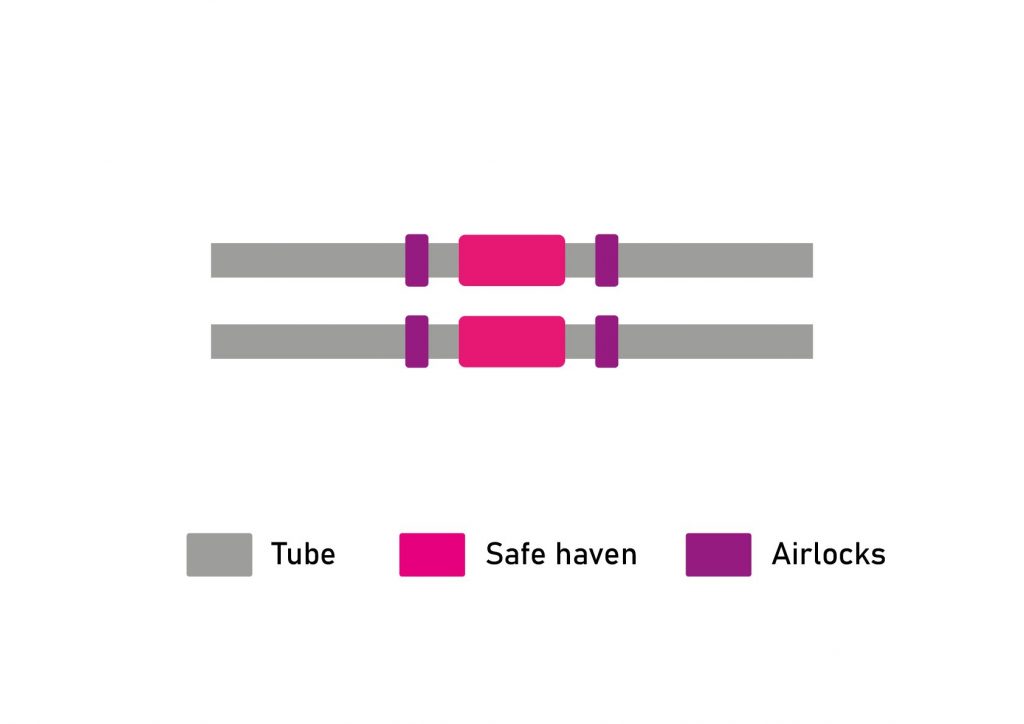A lot of questions asked by people about the full-scale Hyperloop are about evacuation. Passengers must be brought to a safe space in the unfortunate event of an emergency. For a new mode of transportation this is a challenge, especially for one as complex as the Hyperloop as the controlled low-pressure environment limits the exit points of the system. To ensure the safety of passengers effective Hyperloop evacuation must be implemented. Arcadis and Delft Hyperloop joined forces to investigate emergency evacuation in the Hyperloop system.
Hyperloop emergencies can be classified as ‘in-pod’ or ‘brick-wall’ emergencies. In-pod emergencies threaten the safety of passengers inside the pod but do not affect the functionality of the system. Brick-wall emergencies prevent pods from reaching their destination. Regardless of the emergency, the availability of a tenable escape route for the passengers is top priority. Two methods of evacuation are proposed for the Hyperloop system.
The first concept, safe havens, is derived from best practices for metro systems. Safe havens are emergency stations located at regular interval throughout the tubes. Pods come to a standstill at the safe haven, which is brought to atmospheric pressure. Passengers can leave the pod and tube through emergency exits. See figure 1 for a schematic overview of the internal safe haven, whereby the safe haven is built into the tube pods travel through.

The second concept is inspired by the evacuation of road and railway tunnels, namely in-tube evacuation. In-tube evacuation allows passengers to evacuate by foot or with a rescue pod. During an emergency, the pressure is locally brought to atmospheric pressure and passengers are able to evacuate the pod through doors located at the front and back of the pod. These are the same doors used to (dis)embark pods at stations. Passengers walk, opposite to the travel direction of the pod, towards the nearest emergency exit. Pods close to the accident are available to pick up stranded passengers.
Combined evacuation
Internal safe havens prove to be effective for in-pod emergencies. In-tube evacuation allows for safe evacuation during brick-wall emergencies. However, to ensure safety during all emergencies, the best of both concepts is merged into a new evacuation method: combined evacuation. Using this method, pods aim to reach the nearest safe haven. If the track is blocked or a technical failure is experienced, the pod makes an emergency stop. Passengers will evacuate the pod and follow the signs to the nearest emergency exit.
Using combined evacuation, the Hyperloop system offers passengers two independent evacuation routes, thereby significantly improving the availability of a safe escape route during emergencies. However, implementing evacuation routes is not sufficient. An extensive evacuation plan, describing the steps the between detecting and resolving an incident, is crucial. The plan includes a description of the operational use of the system and provides an overview of the responsibilities and parties involved with evacuation. Furthermore, the available equipment, provisions and facilities are also included.
Using combined evacuation, the Hyperloop system offers passengers two independent evacuation routes, thereby significantly improving the availability of a safe escape route during emergencies. However, implementing evacuation routes is not sufficient. An extensive evacuation plan, describing the steps the between detecting and resolving an incident, is crucial. The plan includes a description of the operational use of the system and provides an overview of the responsibilities and parties involved with evacuation. Furthermore, the available equipment, provisions and facilities are also included.
Conclusion
The Hyperloop offers high-speed and sustainable transportation by travelling through a low-pressure controlled environment. This controlled environment limits the exits points of the Hyperloop system and evacuation routes are necessary. Ensuring safety during both in-pod and brick-wall emergencies requires the implementation of combined evacuation. Combined evacuation places safe havens at regular intervals where pods can stop and evacuate passengers. In-tube evacuation can be used when the nearest safe haven cannot be reached. With the help of combined evacuation, the Hyperloop system will ensure the availability of safe escape routes at all times.
The research conducted into Hyperloop evacuation was done in collaboration with Arcadis. Arcadis is an international engineering and consultancy firm focussed on construction, transportation and safety. The collaboration was kicked-off with a brainstorm session where several evacuation methods were discussed. Using the input from the brainstorm session and the expertise of Arcadis as guidance, the concept of combined evacuation was proposed. We look back at a very pleasant and informative collaboration!



2 Comments
S Chowdhury · July 1, 2020 at 2:45 pm
Combined evacuation is increasing redundancy. But this has additional cost implication. In -tube evacuation allows evacuation in both the cases, – In-pod and Brick wall. The total tube can be segmented all along the length for air lock and evacuation can be done by adopting In – tube evacuation. Cost aspect appears less comparable to Combined system and 100% redundancy is also achieved.
Delft Hyperloop · July 6, 2020 at 9:45 am
Combined evacuation does create redundant evacuation routes. Using only in-tube evacuation would significantly increase the required evacuation time as internal safe havens facilitate an efficient evacuation process. A trade-off between benefits and costs is needed to determine if the improvement in evacuation time outweighs the extra costs.